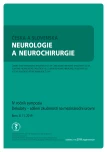The knowledge and practises of nurses in the prevention of medical devices related injuries in intensive care – questionnaire survey
Authors:
V. Kambová; A. Pokorná; S. Saibertová
Authors place of work:
Katedra ošetřovatelství a porodní asistence, LF MU, Brno
Published in the journal:
Cesk Slov Neurol N 2019; 82(Supplementum 1): 19-22
Category:
Původní práce
doi:
https://doi.org/10.14735/amcsnn2019S19
Summary
Aim: To analyse the knowledge and practises of nurses in the field of injuries related to medical devices in intensive care and standard units in the field of surgical and general medicine in a selected group of nurses.
Patients and methods: The questionnaire survey was conducted in two districts and two university hospitals. Statistical data analysis was performed using SPSS for Windows version 21.0 at a significance level of 0.05.
Results: A total of 246 general nurses (89 standard units, 159 intensive care units) were included in the survey. Nasogastric tube and tracheostomy tube, which were most commonly inspected at the standard ward, were considered the most hazardous medical devices. The nurses in the whole group evaluated subjectively their knowledge as good. The subjective evaluation of knowledge about the risks of injury was not statistically related to age or education (P > 0.05) but was related to the length of practice in intensive care units (P = 0.01). Differences were found in the frequency of skin inspection under the medical devices according to the type of workplace (P < 0.05). The skin under the oximeter and the blood pressure cuff were more frequently inspected by nurses at intensive care units.
Conclusion: Knowledge in injury prevention under medical devices is inadequate and risks are underestimated. Intensive care nurses consider preventative measures to be more significant.
Keywords:
pressure ulcer – medical devices related injuries – nursing knowledge – risk
Zdroje
1. Alves P, Eberhardt T, Soares R et al. Differential diagnosis in pressure ulcers and medical devices. Cesk Slov Neurol N 2017; 80/ 113 (Suppl 1): S29– S35. doi: 10.14735/ amcsnn2017S29.
2. Pokorná A, Benešová K, Jarkovský J et al. Pressure injuries in inpatient care facilities in the Czech Republic. J Wound Ostomy Continence Nurs 2017; 44(4): 331– 335. doi: 10.1097/ WON.0000000000000344.
3. Gunningberg L, Hommel A, Bååth C et al. The first national PU prevalence survey in county council and municipality settings in Sweden. J Eval Clin Pract 2013; 19(5): 862– 867. doi: 10.1111/ j.1365-2753.2012.01865.x.
4. Demarré L, Van Lancker A, Van Hecke A et al. The cost of prevention and treatment of pressure ulcers: a systematic review. Int J Nurs Stud 2015; 52(11): 1754– 1774. doi: 10.1016/ j.ijnurstu.2015.06.006.
5. Demarré L, Verhaeghe S, Annemans L et al. The cost of pressure ulcer prevention and treatment in hospitals and nursing homes in Flanders: a cost-of-illness study. Int J Nurs Stud 2015; 52(7): 1166– 1179. doi: 10.1016/ j.ijnurstu.2015.03.005.
6. Pokorná A, Mužík J, Búřilová P et al. Monitoring tlakových lézí – validace datasetu po druhém pilotním sběru dat. Cesk Slov Neurol N 2018; 81/ 114 (Suppl 1): S6– S12. doi: 10.14735/ amcsnn2018S6.
7. Fletcher J. Device related pressure ulcers made easy. Wounds UK 2012; 8(2): 1– 4.
8. Jaul E. A prospective pilot study of atypical pressure ulcer presentation in a skilled geriatric unit. Ostomy Wound Manage 2011; 57(2): 49– 54.
9. Apold J, Rydrych D. Preventing device-related pressure ulcers: using data to guide statewide change. J Nurs Care Qual 2012; 27(1): 28– 34. doi: 10.1097/ NCQ. 0b013e31822b1fd9.
10. Norman J. Medical devices pressure ulcers: who thought plastic tubing could be harmful? Healthy skin 2013: 24– 32.
11. Wilson M. Medical device-related pressure ulcers: what they are and how to prevent them. Wound Essentials 2013; 8(2): 45– 48.
12. Gefen A. Deformation is a cell „Killer“ – implications for protecting persons with a spinal cord injury from pressure. Cesk Slov Neurol N 2017; 80/ 113 (Suppl 1): S21– S24. doi: 10.14735/ amcsnn2017S21.
13. Black J, Alves P, Brindle CT et al. Use of Wound dressing to enhance prevention of pressure ulcers caused by Medical devices. Int Wound J 2015; 12(3): 322– 327. doi: 10.1111/ iwj.12111.
14. Ambutas S, Staffileno BA, Fogg L. Reducing nasal pressure ulcers with an alternative taping device. Medsurg Nursing 2014; 23(2): 96– 100.
15. Black J, Cuddigan JE, Walko MA et al. Medical device related pressure ulcers in hospitalized patients. Int Wound J 2010; 7(5): 358– 365. doi: 10.1111/ j.1742-481X.2010.00699.x.
16. Beeckman D. Incontinence – associated dermatitis – current knowledge on aetiology, diagnosis and prevention. Cesk Slov Neurol N 2016; 79/ 112 (Suppl 1): S28– S30. doi: 10.14735/ amcsnn2016S28.
17. Haesler E (ed). National pressure ulcer advisory panel, european pressure ulcer advisory panel and pan pacific. pressure injury alliance. prevention and treatment of pressure ulcers: quick reference guide. Osborne Park, Australia: Cambridge Media 2014. [online]. Available from URL: https: / / www.npuap.org/ wp-content/ uploads/ 2014/ 08/ Updated-10-16-14-Quick-Reference-Guide-DIGITAL-NPUAP-EPUAP-PPPIA-16Oct2014.pdf.
Štítky
Detská neurológia Neurochirurgia NeurológiaČlánok vyšiel v časopise
Česká a slovenská neurologie a neurochirurgie

2019 Číslo Supplementum 1
- Metamizol jako analgetikum první volby: kdy, pro koho, jak a proč?
- MUDr. Lenka Klimešová: Multiodborová vizita je kľúč k efektívnejšej perioperačnej liečbe chronickej bolesti
- Realita liečby bolesti v paliatívnej starostlivosti v Nemecku
Najčítanejšie v tomto čísle
- Kvalita života pacientů s nehojící se ranou
- Znalosti a zvyklosti všeobecných sester v prevenci ran v souvislosti se zdravotnickými prostředky v intenzivní péči – dotazníkový průzkum
- Využití podtlakové terapie k řešení ranných komplikací po angiochirurgických výkonech
- Podtlaková léčba u pacienta s dekubitem a paraplegií
